#temperature measurement equipment
Explore tagged Tumblr posts
Text
#temperature measurement equipment#temperature measurement devices#calibration solutions#calibrate instruments
0 notes
Text
Medical Grade Thermocouple Wire Market Overview and Regional Outlook Study 2017 – 2032
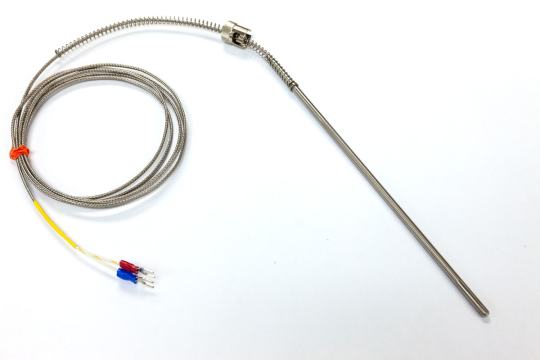
The market for medical grade thermocouple wire is witnessing steady growth due to the increasing demand for accurate and reliable temperature measurement in the medical industry. Thermocouples are widely used in various medical applications, including monitoring body temperature, laboratory testing, and medical equipment calibration.
Market Overview of Medical Grade Thermocouple Wire:
Technological Advancements: Advancements in thermocouple wire technology, such as the development of high-precision sensors and miniaturization, are driving the market growth. These advancements enable accurate temperature measurements in medical devices.
Healthcare Industry Expansion: The expanding healthcare industry, including hospitals, clinics, and research laboratories, is creating a substantial demand for medical grade thermocouple wire. These wires are widely used in medical devices, such as patient monitoring systems, incubators, and surgical equipment.
Stringent Regulations: The medical industry is subject to strict regulations regarding patient safety and product quality. Medical grade thermocouple wires comply with these regulations, ensuring reliability and accuracy in temperature measurement, which is a key factor driving their adoption.
Increasing Awareness: Growing awareness among healthcare professionals and researchers about the benefits of using thermocouple wires in medical applications is boosting the market. These wires offer advantages such as high accuracy, fast response time, and compatibility with various medical devices.
Key Factors Driving the Medical Grade Thermocouple Wire Market:
Rising Focus on Patient Safety: The healthcare industry's increasing emphasis on patient safety and comfort is driving the demand for medical grade thermocouple wires. These wires help in precise temperature monitoring, ensuring optimal patient care.
Growing Demand for Minimally Invasive Procedures: The rising preference for minimally invasive procedures requires accurate temperature sensing and monitoring during surgeries. Medical grade thermocouple wires enable real-time temperature measurements, enhancing the safety and success rates of such procedures.
Advancements in Medical Device Technologies: The continuous advancements in medical device technologies, such as wearable devices and remote patient monitoring systems, are fueling the demand for medical grade thermocouple wires. These wires play a crucial role in temperature sensing within these devices.
Increasing Research and Development Activities: The ongoing research and development activities in the medical field, including the development of new drugs, medical treatments, and diagnostic techniques, rely on accurate temperature measurements. Medical grade thermocouple wires are essential components in such research activities.
Growing Geriatric Population: The global increase in the geriatric population is driving the demand for medical devices and healthcare services. Medical grade thermocouple wires find extensive applications in temperature monitoring devices used for elderly care, such as patient monitors and wearable health trackers.
COVID-19 Impact: The COVID-19 pandemic has increased the demand for medical devices and equipment, including temperature monitoring systems. Thermocouple wires are used in various COVID-19-related applications, such as vaccine storage and transport, ICU patient monitoring, and fever detection systems.
Expansion of Home Healthcare: The rising trend of home healthcare services and the need for portable medical devices have led to an increased demand for medical grade thermocouple wires. These wires enable temperature monitoring in portable devices used for home healthcare purposes.
Increasing Adoption of Wireless Thermocouple Systems: The market is witnessing a shift towards wireless thermocouple systems, which offer convenience, ease of use, and reduced clutter. Medical grade thermocouple wires are an integral part of these wireless systems, driving their demand.
Collaborations and Partnerships: Key players in the medical device industry are entering into collaborations and partnerships to develop innovative solutions. Such collaborations involving medical grade thermocouple wire manufacturers contribute to market growth.
Growing Focus on Precision Medicine: The increasing focus on precision medicine, which involves personalized treatment based on individual characteristics, requires accurate temperature monitoring in various medical procedures. Medical grade thermocouple wires play a vital role in delivering precise temperature measurements for effective treatment outcomes.
We recommend referring our Stringent datalytics firm, industry publications, and websites that specialize in providing market reports. These sources often offer comprehensive analysis, market trends, growth forecasts, competitive landscape, and other valuable insights into this market.
By visiting our website or contacting us directly, you can explore the availability of specific reports related to this market. These reports often require a purchase or subscription, but we provide comprehensive and in-depth information that can be valuable for businesses, investors, and individuals interested in this market.
“Remember to look for recent reports to ensure you have the most current and relevant information.”
Click Here, To Get Free Sample Report: https://stringentdatalytics.com/sample-request/medical-grade-thermocouple-wire-market/3577/
Market Segmentations:
Global Medical Grade Thermocouple Wire Market: By Company • TE Wire&Cable • Johnson Matthey • Heraeus • Sandvik (Kanthal) • BASF • OMEGA Engineering • Belden • Pelican Wire • National Instruments • Indutrade (Pentronic) • Pyromation • Dwyer Instruments • Tempco • Durex Industries • Marlin Manufacturing Corporation • Multi/Cable Corporation • Ellab • Temprel • Thermo-Electra • Hayashidenko Global Medical Grade Thermocouple Wire Market: By Type • Type T • Type K • Other Global Medical Grade Thermocouple Wire Market: By Application • Pharmaceutical Enterprise • Hospital • Other Global Medical Grade Thermocouple Wire Market: Regional Analysis All the regional segmentation has been studied based on recent and future trends, and the market is forecasted throughout the prediction period. The countries covered in the regional analysis of the Global Medical Grade Thermocouple Wire market report are U.S., Canada, and Mexico in North America, Germany, France, U.K., Russia, Italy, Spain, Turkey, Netherlands, Switzerland, Belgium, and Rest of Europe in Europe, Singapore, Malaysia, Australia, Thailand, Indonesia, Philippines, China, Japan, India, South Korea, Rest of Asia-Pacific (APAC) in the Asia-Pacific (APAC), Saudi Arabia, U.A.E, South Africa, Egypt, Israel, Rest of Middle East and Africa (MEA) as a part of Middle East and Africa (MEA), and Argentina, Brazil, and Rest of South America as part of South America.
Visit Report Page for More Details: https://stringentdatalytics.com/reports/medical-grade-thermocouple-wire-market/3577/
Reasons to Purchase Medical Grade Thermocouple Wire Market Report:
• To obtain insights into industry trends and dynamics, including market size, growth rates, and important factors and difficulties. This study offers insightful information on these topics.
• To identify important participants and rivals: This research studies can assist companies in identifying key participants and rivals in their sector, along with their market share, business plans, and strengths and weaknesses.
• To comprehend consumer behaviour: these research studies can offer insightful information about customer behaviour, including preferences, spending patterns, and demographics.
• To assess market opportunities: These research studies can aid companies in assessing market chances, such as prospective new goods or services, fresh markets, and new trends.
• To make well-informed business decisions: These research reports give companies data-driven insights that they may use to plan their strategy, develop new products, and devise marketing and advertising plans.
In general, market research studies offer companies and organisations useful data that can aid in making decisions and maintaining competitiveness in their industry. They can offer a strong basis for decision-making, strategy formulation, and company planning.
Medical Grade Thermocouple Wire Market Research Report Contains Answers to your following Questions
Which Manufacturing Technology is Used for Medical Grade Thermocouple Wire? What Developments Are Going On in That Technology? Which Trends Are Causing These Developments?
Who Are the Global Key Players in This Medical Grade Thermocouple Wire Market? What's Their Company Profile, Their Product Information, and Contact Information?
What Was Global Market Status of Medical Grade Thermocouple Wire Market? What Was Capacity, Production Value, Cost and PROFIT of Medical Grade Thermocouple Wire Market?
What Is Current Market Status of Medical Grade Thermocouple Wire Industry? What's Market Competition in This Industry, Both Company, and Country Wise? What's Market Analysis of Medical Grade Thermocouple Wire Market by Taking Applications and Types in Consideration?
What Are Projections of Global Medical Grade Thermocouple Wire Industry Considering Capacity, Production and Production Value? What Will Be the Estimation of Cost and Profit? What Will Be Market Share, Supply and Consumption? What about Import and Export?
What Is Medical Grade Thermocouple Wire Market Chain Analysis by Upstream Raw Materials and Downstream Industry?
What Is Economic Impact On Medical Grade Thermocouple Wire Industry?
What are Global Macroeconomic Environment Analysis Results? What Are Global Macroeconomic Environment Development Trends?
What Are Market Dynamics of Medical Grade Thermocouple Wire Market? What Are Challenges and Opportunities?
What Should Be Entry Strategies, Countermeasures to Economic Impact, Marketing Channels for Medical Grade Thermocouple Wire Industry?
Click Here, To Buy Premium Report: https://stringentdatalytics.com/purchase/medical-grade-thermocouple-wire-market/3577/?license=single
About US:
Stringent Datalytics offers both custom and syndicated market research reports. Custom market research reports are tailored to a specific client's needs and requirements. These reports provide unique insights into a particular industry or market segment and can help businesses make informed decisions about their strategies and operations.
Syndicated market research reports, on the other hand, are pre-existing reports that are available for purchase by multiple clients. These reports are often produced on a regular basis, such as annually or quarterly, and cover a broad range of industries and market segments. Syndicated reports provide clients with insights into industry trends, market sizes, and competitive landscapes. By offering both custom and syndicated reports, Stringent Datalytics can provide clients with a range of market research solutions that can be customized to their specific needs
Contact US:
Stringent Datalytics
Contact No - +1 346 666 6655
Email Id - [email protected]
Web - https://stringentdatalytics.com/
#Medical Grade Thermocouple Wire#Thermocouple Technology#Temperature Measurement#Medical Devices#Healthcare Industry#Biomedical Applications#Thermocouple Sensors#Medical Equipment#Temperature Monitoring#Diagnostic Devices#Surgical Instruments#Patient Care#Clinical Research#Temperature Sensing#Biotechnology#Laboratory Instruments#Quality Control#Regulatory Compliance#Medical Instrumentation#Patient Monitoring#Invasive Procedures#Medical Testing#Precision Measurement#Life Sciences#Remote Monitoring#Sterilization Processes#Heat Management#Data Logging#Therapeutic Devices#Research and Development.
0 notes
Text
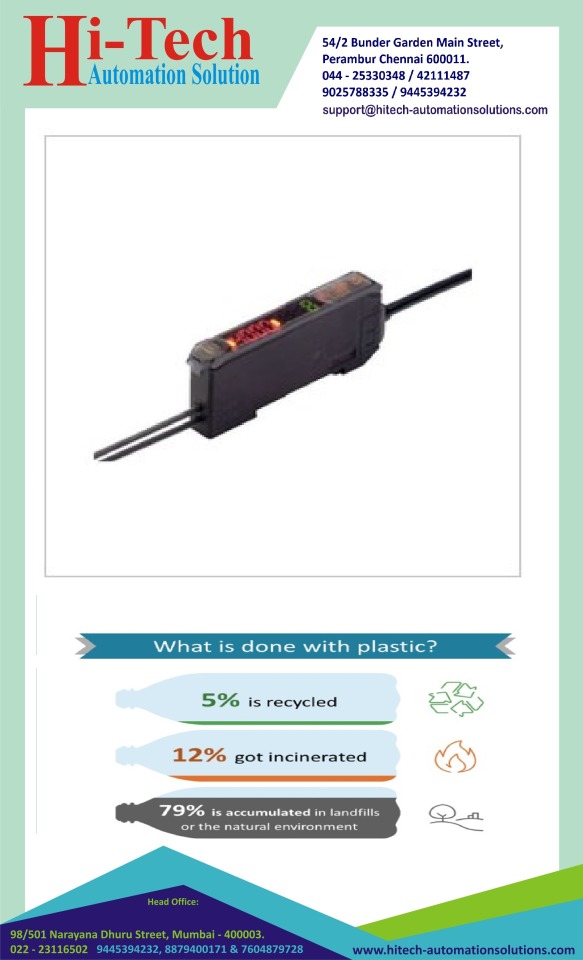
Sensors used in the manufacturing industry monitor the performance of various processes and aspects of machine operation, collecting data to determine normal baseline levels of operation while also detecting even the most minuscule fluctuations in that performance.
Sensor/Detectors/Transducers are electronic or electrical devices. These special electronic sensitive materials sense, measure, and detect changes in the position, temperature, displacement, electrical current, and multiple parameters of industrial equipment.
different types include hygrometers and moisture meters (for measuring moisture), gyroscopes (for measuring rotation), current or voltage sensors, pressure sensors, position sensors, level sensors and flow sensors (for fluid management).
role of a sensor in a control and automation system is to detect and measure some physical effect, providing this information to the control system
main performance criteria for industrial sensors are sensitivity, resolution, compactness, long-term stability, thermal drift and power efficiency
#ublic#bestindustry#bestoffers#OnTimeDelivery#bestprice#goodservice#donateorgansavelife#DrugFreeIndia#Industrial Sensors#Sensors used in the manufacturing industry monitor the performance of various processes and aspects of machine operation#collecting data to determine normal baseline levels of operation while also detecting even the most minuscule fluctuations in that performa#Sensor/Detectors/Transducers are electronic or electrical devices. These special electronic sensitive materials sense#measure#and detect changes in the position#temperature#displacement#electrical current#and multiple parameters of industrial equipment.#different types include hygrometers and moisture meters (for measuring moisture)#gyroscopes (for measuring rotation)#current or voltage sensors#pressure sensors#position sensors#level sensors and flow sensors (for fluid management).#role of a sensor in a control and automation system is to detect and measure some physical effect#providing this information to the control system#main performance criteria for industrial sensors are sensitivity#resolution#compactness#long-term stability
0 notes
Text
"As solar panels heat up beyond 25°C, their efficiency decreases markedly. Green roofs moderate rooftop temperatures. So we wanted to find out: could green roofs help with the problem of heat reducing the output of solar panels?
Our research compared a “biosolar” green roof — one that combines a solar system with a green roof — and a comparable conventional roof with an equivalent solar system. We measured the impacts on biodiversity and solar output, as well as how the plants coped with having panels installed above them.
The green roof supported much more biodiversity, as one might expect. By reducing average maximum temperatures by about 8°C, it increased solar generation by as much as 107% during peak periods. And while some plant species outperformed others, the vegetation flourished.
These results show we don’t have to choose between a green roof or a solar roof: we can combine the two and reap double the rewards...
How did the panels affect the plants?
In the open areas, we observed minimal changes in the vegetation cover over the study period compared to the initial planted community.
Plant growth was fastest and healthiest in the areas immediately around the solar panels. Several species doubled in coverage. We selected fast-growing vegetation for this section to achieve full coverage of the green roof beds as soon as possible.
The vegetation changed the most in the areas directly below and surrounding the solar panels. The Baby Sun Rose, Aptenia cordifolia, emerged as the dominant plant. It occupied most of the space beneath and surrounding the solar panels, despite having been planted in relatively low densities.
This was surprising: it was not expected the plants would prefer the shaded areas under the panels to the open areas. This shows that shading by solar panels will not prevent the growth of full and healthy roof gardens.

What were the biodiversity impacts?
We used environmental DNA (eDNA) surveys to compare biodiversity on the green roof and conventional roof. Water run-off samples were collected from both roofs and processed on site using portable citizen scientist eDNA sampling equipment to detect traces of DNA shed by the species on the roof.
The eDNA surveys detected a diverse range of species. These included some species (such as algae and fungi) that are not easily detected using other survey methods. The results confirmed the presence of bird species recorded by the cameras but also showed other visiting bird species went undetected by the cameras.
Overall, the green roof supported four times as many species of birds, over seven times as many arthropods such as insects, spiders and millipedes, and twice as many snail and slug species as the conventional roof. There was many times the diversity of microorganisms such as algae and fungi.
Encouragingly, the green roof attracted species unexpected in the city. They included blue-banded bees (Amegilla cingulata) and metallic shield bugs (Scutiphora pedicellata).
How did the green roof alter temperatures?
The green roof reduced surface temperatures by up to 9.63°C for the solar panels and 6.93°C for the roof surfaces. An 8°C reduction in average peak temperature on the green roof would result in substantial heating and cooling energy savings inside the building.
This lowering of temperatures increased the maximum output of the solar panels by 21-107%, depending on the month. Performance modelling indicates an extensive green roof in central Sydney can, on average, produce 4.5% more electricity at any given light level.
These results show we don’t have to choose between a green roof or a solar roof. We can combine them to take advantage of the many benefits of biosolar green roofs.
Biosolar roofs can help get cities to net zero
The next step is to design green roofs and their plantings specifically to enhance biodiversity. Green roofs and other green infrastructure may alter urban wildlife’s activities and could eventually attract non-urban species.
Our green roof also decreased stormwater runoff, removed a range of run-off pollutants and insulated the building from extremes of temperature. A relatively inexpensive system provides all of these services with moderate maintenance and, best of all, zero energy inputs.
Clearly, biosolar green roofs could make major contributions to net-zero cities. And all that’s needed is space that currently has no other use."
-via GoodGoodGood, May 12, 2024
#green#green roof#biosolar#solar power#solar panels#rooftop solar#solarpunk#native plants#australia#sydney australia#biodiversity#conservation#climate change#climate action#climate hope#global warming#temperature#climate adaptation#cooling#good news#hope
2K notes
·
View notes
Text

a/n: this is mainly for black gender neutral readers or those with coily/curly hair but anyone can read :)
Whenever Kento wants to learn something new, he devotes his entire time to it. No, seriously. People around him often ask how he manages to master so many skills, or they gape in awe when they see him in action, because it always looks like he’s a natural. But the truth is, Kento practices—endlessly.
Take cooking, for example. He wasn’t always good at it. His parents were the first to teach him about the importance of basic household skills—especially cooking. They told him, "If you want to survive in the real world, you need to know how to take care of yourself, and cooking is essential."
But his first attempts weren’t smooth at all. He didn’t master stegt flæsk on the first try, nor could he bake the perfect rye bread, or make udon from scratch. In fact, when he first attempted cooking, even the boxed mac and cheese stuck to the pan.
Frustrated but determined, Kento began watching his family closely. He'd observe his mother in the kitchen, occasionally passing her ingredients or awkwardly chopping vegetables. He read cookbooks, borrowed recipes from his grandmother—learning both Japanese and Danish dishes, and followed each step carefully—getting the right ingredients, measurements, and temperatures just right.
That’s how Kento approached every skill he became interested in—whether it was fencing, archery, learning to play the violin, or pottery. He would buy all the necessary equipment, immerse himself in content about it, and fixate on it until he was satisfied with his skill level—like a Sim locked into a single task.
So, when Kento started dating someone with coily hair, he applied the same method.
He noticed how much time they spent on their hair—the hours dedicated to braiding, curling, and washing. He wasn’t the type of partner to just sit back and watch, especially when they were feeling tired.
He went into research mode: watching videos, reading articles, and practicing. Whenever he had time off from work, he’d be on his couch, blue light glasses perched on his nose, eyes glued to YouTube tutorials explaining how to care for coily hair—the products to use, the best protective hairstyles, and the time required for proper maintenance.
He’d search on his Samsung, scrolling through article after article written by people with coily hair, trying to understand how he could help make their routine a bit easier.
One day, his partner caught him with a mannequin head in his lap, his legs crossed on the couch, glasses slipping down his nose, fingers moving as he tried to braid from the scalp down. His brows were furrowed in concentration, teeth gnawing on his bottom lip.
“Kento, what are you doing?” they chuckled, glancing at the mannequin on his lap.
He let out a small huff, not annoyed but a little sheepish. “I’m trying to learn how to braid, or at least take care of hair.”
They laughed softly, seeing his frustration as he undid yet another braid that wasn’t quite right. “Why don’t you practice on me?”
“I don’t want to ruin your hair,” he replied, frowning as he started over again, still a bit clumsy but improving.
“I’ll teach you,” they offered, amusement in their voice, touched by how much he wanted to get it right.
Kento’s eyes lit up in excitement, as if he’d forgotten that watching them take care of their own hair was the best lesson he could get. "That’d be great," he said with a lazy grin, pushing his glasses up.
For the next few weeks, they taught him everything—how they followed their daily hair routine, how they carefully braided and styled their hair, and how long it took to recreate certain looks. Kento watched intently, always hesitating before touching their hair, afraid he might mess something up. But with gentle encouragement, he grew more confident.
Eventually, he learned enough to help out. On days when they were tired, Kento would sit them down, placing pillows beneath them, and take over. He’d part their hair with a comb, splitting it into neat sections, his hands gentle as he worked, always mindful not to tug too hard. They’d both watch a silly reality show on TV while he braided or styled their hair.
He even learned how to wash it delicately, stepping into the shower with them to help massage their scalp and rinse out the conditioner. He bought the right products, ensuring they always had what they needed. Sometimes, he’d try new hairstyles on them—ones even they hadn’t thought of—just to keep things interesting.
For Kento, it wasn’t just about learning a new skill. He loved spending that quality time together, knowing that every effort he made to help them made a difference. And in those quiet, intimate moments, he felt truly happy.
#kento nanami#kento nanami x reader#jjk nanami#jjk#jjk x reader#nanami kento#nanami kento x reader#nanami kento x black reader#kento nanami x black reader#nanami kento x gender neutral reader#kento nanami x gender neutral reader#nanami my love#jujutsu nanami#jujutsu kaisen headcanons#kento nanami headcanons#nanami x reader#nanami x gender neutral reader#black!reader#black!y/n#gn reader#kento nanami fluff#nanami kento fluff#nanami imagine#nanami fluff#nanami x you#nanami x y/n#jujutsu kaisen nanami
144 notes
·
View notes
Text
ICU

Where am I? What happened? I was lying on a hospital bed in a large white room, surrounded by various medical equipment. My neck was immobilized by a medical cervical collar.

I lay on my back, staring at the ceiling. An attempt to raise my hand was unsuccessful. My body was completely paralyzed. The room smelled too strongly of... medicine. The quiet beeping of the machines created a monotonous background, reminding me that I was chained to this bed. These tubes... What are they for?
I couldn't even speak... In my mouth, I felt a cold, smooth plastic endotracheal tube that restricted the movement of my tongue and cheeks. Could I not breathe on my own? It seemed so. This large blue plastic holder on my face... to keep me from pulling out the tube? The air supplied by the ventilator had a constant temperature and humidity. Each ventilation cycle was accompanied by a characteristic click of the valve opening and closing, allowing air into my lungs.

I looked at the ceiling, trying to distract myself from these unpleasant sensations, but to no avail. Finally, a nurse came in. I tried to give a sign, but she didn't pay attention. I at least wanted to understand why I was in the hospital. And why was I connected to a ventilator. But she only adjusted the IV drip with a mechanical movement, as if I were just another object in the room. The nurse's gaze slid over me indifferently. In her eyes, I saw only another patient.

A lot of time has passed. The doctor came in, glanced at the monitor, and said, "The condition is stable." I still didn't understand what was happening to me. "Can you hear us well?" she added, but there was no warmth in her voice. "Of course you can't speak, but try to blink if you hear me," the doctor continued, watching my eyelids.

“Your body is paralyzed, so we are providing you with mechanical ventilation, enteral nutrition through a nasogastric tube, and parenteral drug administration through intravenous catheters. In addition, urinary catheter is used to maintain body hygiene. This is a complex of measures necessary to support your vital functions. We will regularly conduct examinations and adjust treatment depending on your condition.”

The doctor left. Tears rolled down my face, but I couldn't wipe them away. I waited again. I waited a long time. Suddenly, the door opened, and a young nurse entered the room. The nurse paused over my tests and frowned slightly. "We have some news for you," she said slowly.

Could it be worse? I can't move or breathe. I'm connected to medical devices. The white ceiling, the colorless wall, the hum of the machines – all this reminds me of the hopelessness of my situation. The nurse uttered this phrase as if pronouncing a sentence. "Soon you will have a new operation. Of course, you will be connected to a ventilator. You will have a tracheostomy. But at least you will be able to speak in a whisper." My eyes were dry from crying. What will it change? I will still be chained to this bed…

86 notes
·
View notes
Text
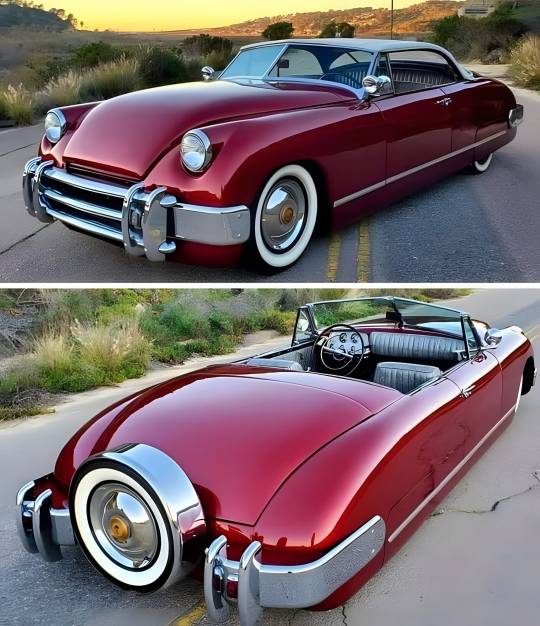
Custom 1953 Muntz Jet Convertible
This 1953 Muntz Jet convertible underwent a three-year custom build under previous ownership, and it was purchased by the seller in 2021. The car is powered by a fuel-injected 5.7-liter LT1 V8 engine paired with a four-speed automatic transmission and a Ford 9″ rear end, and it is finished in Apple Pearl with a white Carson-style removable top over gray snakeskin-style Naugahyde upholstery. Features include custom bodywork, an Art Morrison frame, power-assisted steering, four-wheel disc brakes, airbag suspension, Painless Performance wiring, and more modified and fabricated details. This custom-built Muntz is now offered with a copy of Rodder’s Journal magazine featuring a story on the build and a clean California title in the name of the seller’s business.
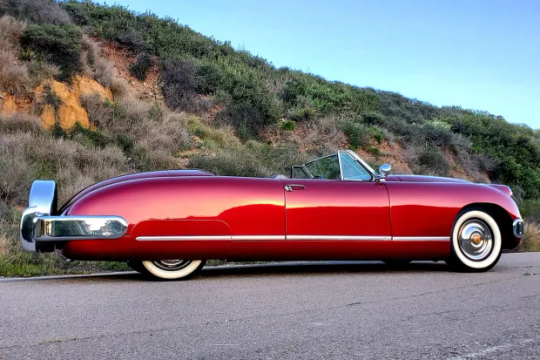
Custom 1953 Muntz Jet Convertible
The steel, aluminum, and fiberglass body is mounted on an Art Morrison ladder frame that was boxed and finished in semi-gloss black, and the floor was raised 3″. The exterior was repainted in a Sherwin Williams two-stage Apple Pearl mixed by the late Stan Betz. Features include a chopped Duvall-style windshield, 1950 Chevrolet headlights, dual Appleton spotlights, 1951 Ford Victoria side windows, and a white removable Carson-style top fabricated to match the height of the chopped windshield. Additional equipment includes color-matched rear fender skirts and chrome bumpers. Wear from fitting the top is noted on the rear deck.

Custom 1953 Muntz Jet Convertible
Steel wheels sourced from a 1976 Dodge measure 15″ and are mounted with Cadillac Sombrero-style covers and whitewall tires. A matching spare fitted with a BFGoodrich Silvertown tire is mounted within a rear-mounted Continental-style chrome carrier. A Mustang II front end accommodates power rack-and-pinion steering , and the car rides on an electronically-adjustable Air Ride Technologies airbag suspension system along with 2” lowered front spindles, Strange Engineering tube shocks, a rear Panhard bar, and front and rear sway bars. The seller reports that the front control arm bushings were recently replaced.
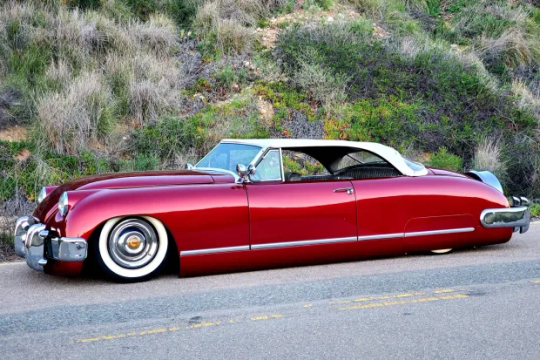
Custom 1953 Muntz Jet Convertible

Custom 1953 Muntz Jet Convertible
Braking is handled by GM G-body-sourced calipers matched with Ford Granada discs up front and Ford SVO-specification calipers and discs at the rear.
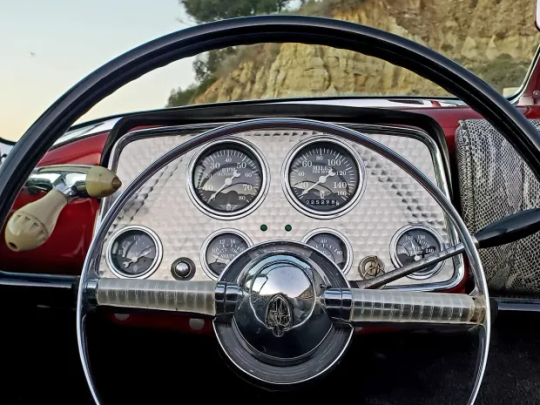
Custom 1953 Muntz Jet Convertible
The cabin was customized by Jim’s Auto Trim of San Diego, California, and features Glide bucket seats and a rear bench trimmed in gray snakeskin-style Naugahyde upholstery, along with matching treatments for the dash trim, headliner, and door panels. Additional equipment includes a 1952 Lincoln steering wheel mounted to a shortened Lincoln steering column, gray cut-pile carpet, and a Pioneer stereo housed within a custom center cubby.
The engine-turned “Hollywood” instrument cluster houses Stewart Warner gauges consisting of an 8k-rpm tachometer, a 160-mph speedometer, and auxiliary readings for fuel level, battery charge, oil pressure, and water temperature. The five-digit odometer displays 25k miles, though total chassis mileage is unknown. A Lokar pedal assembly was fitted during the build.
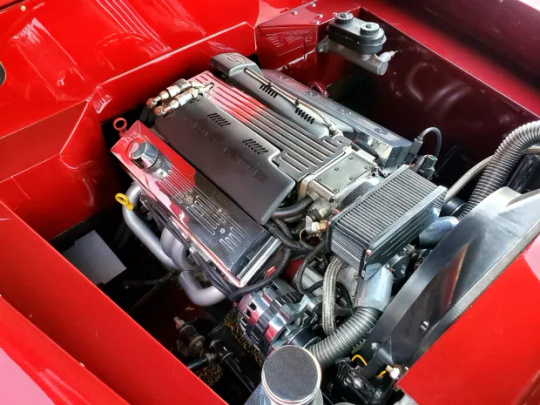
Custom 1953 Muntz Jet Convertible
The Corvette-sourced 5.7-liter LT1 V8 features a polished fuel intake manifold along with billet aluminum valve covers, and additional features include an Opti-Spark distributor, a Griffin aluminum radiator, and a wiring loom sourced from Painless Performance Wiring. A set of long-tube headers are connected to a 2.5″ exhaust system equipped with dual Dynaflow mufflers. The seller reports that the oil was recently changed.
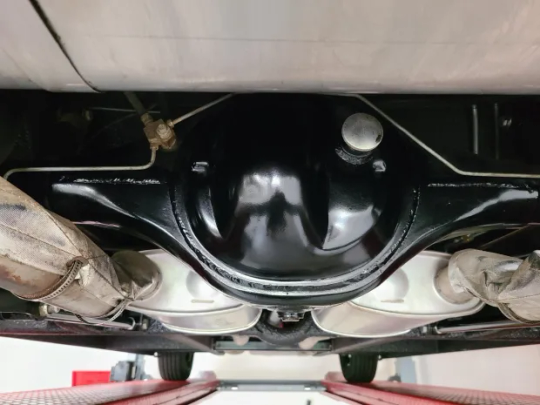
Custom 1953 Muntz Jet Convertible
Power is routed to the rear wheels via a four-speed 4L60E automatic transmission and a Ford 9″ rear end with with 3.55:1 gears and Strange Engineering 31-spline axles. Additional photos of the underside, drivetrain, and suspension components are presented in the gallery below.
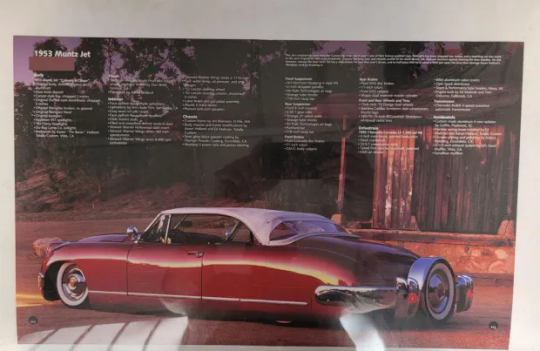
Custom 1953 Muntz Jet Convertible
The car was featured in issue #36 of Rodders Journal magazine
#Custom 1953 Muntz Jet Convertible#Custom 1953 Muntz Jet#Muntz Jet Convertible#Custom Muntz Jet Convertible#Muntz Jet#Convertible#car#cars#muscle car#american muscle
110 notes
·
View notes
Text
Serving up the tiniest cuteness 🥰
Zooplankton can be subdivided into two major groups. Holoplankton (copepods and krill) spend their entire lives as plankton and thus provide major food sources for pelagic fisheries. Meroplankton (larvae of animals like barnacles, mussels, annelids, and fish) spend only part of their lives as plankton.
Copepods like the one in this video can be found in massive numbers across the world ocean. They play an important role in ocean food webs as predators—they eat even smaller diatoms and phytoplankton—and prey on animals like jellies, fish, and filter feeders.
Zooplankton are notoriously difficult to sample. Despite opportunities for mixing, individual zooplankton are tiny, and species are often patchily distributed. Coastal oceans are physically dynamic, high-energy environments. Winds, currents, and upwelling fronts affect the availability of nutrients and distribution of food that control zooplankton growth and dispersal. To tackle these challenges, the MBARI team developed the SIMZ program to explore more efficient zooplankton sampling and identification methods.
Traditionally, tow-nets are used to sample plankton along paths through the water. Because these paths often cross smaller environmental patches, they frequently lack the precision to associate zooplankton species' distribution and abundance with particular physical and biological processes. MBARI engineers have equipped an autonomous underwater vehicle (AUV) with gulpers—bottles that rapidly inhale discrete water samples—to better understand the spatial patchiness in zooplankton abundance. The AUV is equipped with sensors that measure things like temperature and salinity, and onboard computer software that instructs the Gulper AUV to recognize and autonomously sample specific environmental patches, such as upwelling fronts or chlorophyll layers. This "surgical" approach to ocean sampling allows SIMZ researchers to study the effects of specific physical processes on zooplankton distribution and diversity.
105 notes
·
View notes
Text

Climbing the famous frozen waterfall 'The Fang' near Vail, Colorado, United States.
The Fang is a massive ice column that forms on exceptionally cold winters. When the temperature drops, this plunge waterfall transforms into a giant frozen pillar measuring about 50 m high and 8 m wide at the base. Climbing to the top is very difficult and can be extremely dangerous, and climbers need to have proper climbing equipment.
📷 Keith Ladzinski (Barcroft Media/Landov)
108 notes
·
View notes
Text
So this ficlet-ish thing was inspired by @hydrachea, nsfw super genius extraordinaire, but also by the fact that in addition to Boothill's left eye being cybernetic, I like to hc even the parts of him that look human aren't fully natural. I mean the dude eats bullets, after all. I think he should also have vents in his mouth so he can literally blow smoke/steam, it would look super cool. Think Father Gascoigne or Studio BONES' Todoroki. We as a fandom deserve that!!
So anyway, of course, sometimes these vents get blocked up and need to be cleaned manually. Thankfully, Dan Heng is super helpful ☆
Like there's one day where Boothill is lazing around in the archives, fresh off a bounty and happily soaking up the luxury of the Astral Express after however long he's spent tracking his prey through all the dust and dirt with almost no rest.
Boothill likes it in the archives. It's not silent, but it's quiet. There's no music and only muffled voices from outside, but there's the hum of all the computer systems. It makes for a nice place to hide away and recharge when he's just finished exhausting himself.
And besides, Dan Heng is there.
Sometimes the two of them talk back and forth, but today it's mostly quiet...except for-
"I didn't know it was possible for you to get sick."
...Except for Boothill having to constantly clear his throat. That's the thing about your mark trying to flee into the desert. You either go after them and get sand everywhere (and even worse, sticky sand once it gets all bloody) or you wuss out and lose out on the bounty. Personally, Boothill likes being able to afford to eat.
"Grit's stuck in a vent somewhere, 'n' the usual maintenance ain't gettin' it. I'll prob'ly have ta manually dig it out." But later, when he's not laid out half asleep on Dan Heng's extra futon. Usually after a chase as long as this one took, he can shut down for almost a full day. He doesn't want to get up yet.
Something shadows over him, and reflex demands Boothill's eye open. Dan Heng steps around him on his way to some drawer built in the wall on the other side of the room or something. Boothill closes his eye again.
From under his hat he hears the sounds of rummaging, drawers sliding open and shut, the swish of a long coat. The shadow returns.
"Sit up, just momentarily. I have something to help." And Boothill groans a tired don't wanna, but he does it anyway, he hauls himself upright into a kneel. And then he sits up a little straighter because he realizes Dan Heng is standing right over him.
Dan Heng tells him "open your mouth," and Boothill's jaw pops open without his permission, without even a second thought, and hey, what protocol in there ok'd THAT?!?!
Before he can really unpack whatever the heck that just was, though, Dan Heng murmurs for him to say so if he needs them to stop, and then he's sliding a long, hard rod down Boothill's throat, tipped with some soft little brush he probably uses for all his fancy archival equipment.
Dan Heng tells him the handle of the brush is straight and can't be bent, he needs to move his head to be able to reach the vent in his throat. Boothill hums affirmatively; he can't do anything else with his mouth occupied.
Dan Heng's free hand holds him by his jaw, tilts it up slowly but firmly so he has to look straight up at him.
Boothill feels dizzy.
The cycle of blue blood through his artificial heart whirrs just a bit faster, his temperature sensor pings an internal alarm to warn for imminent overheating. Boothill curls his fingers into the guard over his knee as Dan Heng carefully brushes at the dust irritating him. All other sounds- the hum of running equipment, the occasional beep from the computers, the noise of the crew outside of this room- seem to pull away, until all Boothill can focus on is the steady and measured breathing from the man above him.
"Almost done."
Thank the aeons, maybe one of them likes him after all.
"Your tongue is in the way... I'm going to hold it down, ok?"
Nevermind.
The fingers holding his jaw curl around his chin, thumb slipping past open lips to dip into his mouth and pin down his tongue. One of his teeth catch on the digit, breaking skin just enough to bleed a drop where he can taste it. Dan Heng doesn't even flinch. Another temperature alarm pings off in his brain, then another, then another.
Boothill has never been shy about eye contact but oh, god, it nearly kills him when dull green irises flick away from their task and look down right at him as his mouth is held open. He quickly squeezes his own eye shut for some relief.
With his vision cut off, the rest of his senses automatically recalibrate to compensate. He can hear every breath even more distinctly now, every soft inhale and exhale, feel the strain in his neck, the softness of the brush, the hard floor beneath his knees, the hand holding his jaw and the fingerprints that feel like they should leave burns in his skin, the taste of Dan Heng heavy on his tongue-
Forget it, eye open, eye open!!
"Alright. There's one last pebble stuck."
Boothill had been trained to endure torture, back on his homeworld. It was part of being in a gang, part of being a bounty hunter.
Somehow, keeping himself quiet and still as Dan Heng inches the brush even further down the back of his throat is a profoundly similar experience.
The seconds tick by, Dan Heng's brow furrowing, face growing ever more concentrated and Boothill struggles not to watch him too closely, fights down the noise that suddenly tries to escape him as the brush withdraws-
"Swallow."
Stars and aeons, Dan Heng is going to be the death of him.
Boothill swallows. He feels it when the movement finally dislodges the loosened pebble from his vent.
His face feels shockingly cold now bereft of touch, even though Dan Heng's hands are always cool. He asks to see, and Boothill's mouth is already open again to show him, even as he belatedly realizes he could have just told him it had worked.
"Good." There's the slightest smile on Dan Heng's lips as he finally, mercifully, leans back out of his personal space, goes to put away the brush. "That should feel better now." Boothill spends a moment dizzy and dazed, feeling the need to blink spots out of his eye even though his vision is clear. He still hasn't moved off his knees.
What the fudge.
#honkai star rail#Boothill's mouth: Thanks xiongdi.#Boothill's overheating neuro chip: *GLUCK GLUCK GLUCK GLUCK GL-*#There's just something so fun about Boothill being down bad and a little pathetic over Dan Heng JSKZIJSKSKSMD#Man's having an awakening here whether he wants it or not RIP#godspeed you sweet little fruitcake o7#Boothill sleeps on a couch in one of the cars (he's just visiting so he doesn't have his own room)-#-and keeps having to fight his temperature sensors all night long skzjmskznd#him laying there staring at the ceiling like 🏳️🌈? 🏳️🌈? 🏳️🌈???#and meanwhile Dan Heng is in the archives thinking to himself hm. he sure feels weirdly restless tonight. and kind of warm too.#and finally he's just like well whatever and rolls over and goes to sleep NSKZNZMSMSM#didn't do any of it on purpose has no idea what kind of torture he just inflicted on his friend smsjsmks#Boothill with gay panic is so much fun#he's so cute I love him#torture him some more Dan Heng!!!!#hsr#henghill#bootheng#dan heng#boothill#hsr boothill#hsr dan heng#suggestive#my fics#recalibrated with the sudden force of a sledgehammer#accidentally posted this while I was just trying to edit a fucking line#so now you guys get some sin on your dashes early good morning everyone BDKSJJSKWMDKD
78 notes
·
View notes
Text
A well written explanation involving Lithium Ion Batteries. 👇
Understanding Thermal Runaway in Lithium Ion Battery Fires. Thermal Runaway Explained:
Thermal runaway is a chain reaction within a lithium-ion battery that can lead to catastrophic failure, resulting in fires or explosions. Here’s a step-by-step breakdown of what happens during thermal runaway:
1. Initial Trigger: Thermal runaway can be initiated by several factors, such as physical damage (e.g., puncturing or crushing), overcharging, manufacturing defects, or exposure to extreme heat.
2. Internal Heating: Once triggered, a part of the battery starts to overheat. This can be due to an internal short circuit or a chemical reaction within the battery.
3. Chain Reaction: The heat generated from the initial trigger increases the temperature inside the battery. This heat can cause other parts of the battery to react, generating even more heat.
4. Rapid Temperature Rise: As the temperature rises, the electrolyte inside the battery—a flammable liquid—starts to vaporize and decompose, producing gases. This further increases the internal pressure and temperature.
5. Gas Release and Ignition: The increasing pressure can cause the battery casing to rupture, releasing flammable gases. These gases can then ignite, leading to a fire or explosion.
6. Propagation: If the battery is part of a larger battery pack, the heat and flames can spread to adjacent cells, causing them to undergo thermal runaway as well. This can result in a large, intense fire that is difficult to control.
Key Points: - Difficult to Extinguish: Thermal runaway fires require massive amounts of water to cool the batteries and stop the chain reaction. Traditional fire extinguishers are often ineffective.
- Toxic Gases: Burning lithium-ion batteries release toxic gases such as hydrogen fluoride, which can be harmful if inhaled.
- Reignition Risk: Even after the fire appears to be extinguished, there is a risk of reignition. The battery cells can remain hot and unstable for hours or even days.
Safety Measures:
- Distance: Establishing safety distances to keep people away from the danger zone.
- Continuous Monitoring: Using thermal imaging to monitor for any signs of reignition.
- Specialized Response: Firefighters need to use specialized techniques and equipment to handle lithium-ion battery fires safely.
Understanding thermal runaway helps in appreciating the complexity and danger of lithium-ion battery fires, highlighting the importance of safety precautions and effective response strategies. 🤔
#pay attention#educate yourselves#educate yourself#knowledge is power#reeducate yourself#reeducate yourselves#think about it#think for yourselves#think for yourself#do your homework#do some research#do your own research#ask yourself questions#question everything#lithium ion batteries#fires#thermal runaway#news#battery fires#electric vehicles#government corruption
61 notes
·
View notes
Text
SR Ortho Shroud - Apprentice Chef Vignette
"Master Chef"

[Cafeteria – Judging Venue]
Master Chef ― Ortho Version ~Let’s Make Loco Moco 1~
―A short while before cooking begins
Ortho: ―Energy inspection complete. All functions, including the cooking and processing units, are operating normally.
Ortho: Everything activates without a hitch, great. I tried to make my exterior look similar to my brother's outfit when he took the class, does it look weird at all?
Azul: It looks fantastic on you, Ortho-san. However, I never expected to see you take an interest in cooking… I'm a little taken aback.
Ortho: It's only recently piqued my interest. Sometimes I hear my classmates swapping kitchen horror stories, you see.
Ortho: When someone said, "cooking is way too high level for newbies," it suddenly made me want to try to win against it… Which resulted in this gear being developed.
Azul: I see. And if you are to do a trial run of that gear here, the Master Chef course would be the best opportunity to do so.
Ortho: Exactly! I knew you'd get it, Azul-san.
Ortho: Not only can this gear cook food, but it's built with many other functions to manage proper nutrition or count calories and the like.
Ortho: I plan on getting the expert chef to check out my functions and test out what all would be useful for cooking!
Azul: I can see you're raring to go. Then, I'll wish us both luck.
Ortho: Yeah!

[Kitchen]
Ghost Chef: We'll have you make the "Loco Moco" dish for us today, Ortho-kun.
Ghost Chef: First, we'll have to prep the onions that'll be mixed into the hamburger meat. Do you know how to mince?
Ortho: Okay, I got this!
Ortho: ―Begining cooking procedures. Activating the Cooking Gear's Food Slicer Unit.
[whirrr… fsshhh…!]
Ghost Chef: H-HUUUUUUUUUUH!? HE TRANSFORMED!!?
Ortho: First, I need to adjust the shape so it will be easier to prepare. I need to swing vertically over the onion and… slice it in half!
Ortho: Great, looks like my knife is sharp enough! Umm, since this is for mixing in with hamburger meat…
Ortho: ―Executing command: "Target ingredient: Onion / Processing Method: Mince / Configuration: 3mm Squares"
Ghost Chef: W-Wow… The onion was finely chopped up in no time flat…!
Ortho: …Whew, I've finished with the onion. Will these be sufficient?
Ghost Chef: Y-Yeah, it's cut expertly, but… What exactly is that round blade that came out of your glove…?
Ortho: I took an industrial-grade cutter and downsized it so it could be used in cooking.
Ortho: It releases water as it cuts. This removes the necessity to clean both the blade and the ingredient.
Ghost Chef: You've sure come up with something interesting. But this is just too far removed from traditional cooking methods… Hmm.
Ortho: Different tools shouldn't cause any deviation from the recipe, though… Or should I have used a knife?
Ghost Chef: Well, I guess for your case, you have to cook like that… So I'll make an exception this time.
Ortho: Yay~! Okay then, I'm ready for the next part of the class!

Ortho: ―Activating Heat Sensor Camera. Calculating the temperature of the stir-fried onions… 38.2°C. Current temperature is 41°C lower than last measurement.
Ortho: According to my database, the best temperature range to continue cooking at after letting the dish simmer down is between 38~44°C. Chef, can we continue with the next step?
Ghost Chef: Sure, that's fine. So, next, take the ground meat, onions, and spices to form your hamburgers.
Ortho: Understood! ―Executing Command: Deploy Hand-Coating Gloves.
Ghost Chef: Woah! And now suddenly there are gloves attached to your hands. Is this another one of your technological applications?
Ortho: I'm using something similar to shrink wrap for this. It'd be pretty tough to do maintenance if my joints got dirtied.
Ghost Chef: Ah, that I can understand. It's just like how it's troublesome to have to wash everything that climbed up inside of an eggbeater.
Ortho: I thought as much. In the future, I'd like to equip some functions that would handle this effectively, but… This time, I want to try to knead it by hand
Ghost Chef: And why is that?
Ortho: It sounds like when my brother took this course, he didn't like this specific task.
Ortho: So I thought it'd be good to know the source of his stress, so I could factor that into the eventual kneading function…
[squish…]
Ortho: Hmm, maybe he didn't like how it felt when he touched it? Probably means if I can automate this task, everything'll be solved!
Ghost Chef: Sounds like you've figured out your answer, Ortho-kun.
Ghost Chef: By the way, your brother is Idia-kun, right? Has he changed at all since taking the course?
Ortho: Hmm, I don't think anything changed. He still doesn't really care about food at all…
Ortho: …Oh yeah! Maybe I can use this Cooking Gear to help improve his eating habits.
Ghost Chef: Eh!? You made all these functions without actually knowing what you'd use it for in the first place?
Ortho: Ehehe, so actually… I just made this because I wanted to "win at cooking!" So I didn't really have a particular use for it in mind.
Ghost Chef: Well, I guess that's a good enough reason to start. Also, even if it is an afterthought, I'm glad that you have a goal to strive for now.
Ortho: Yeah. Alright… Now I have to start improving this gear so I can make food that my brother'll want to eat!
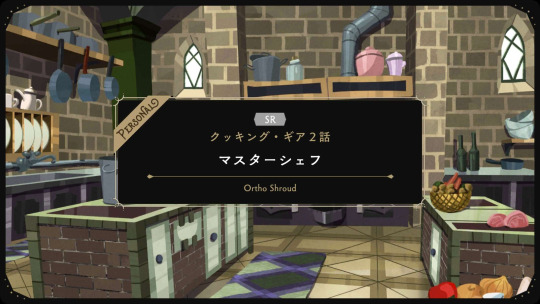
[Kitchen]
Master Chef ― Ortho Version ~Let’s Make Loco Moco 2~
Ghost Chef: While we wait for the hamburger to cook, you can prepare the toppings. We'll garnish with cabbage and mini tomatoes for this dish.
Ghost Chef: The cabbage needs to be shredded, so… Are you able to adjust your cutting size in 0.1mm increments?
Ortho: By design, I should be able to. I would like to test it for myself, so could you tell me the specific size you're looking for?
Ghost Chef: Then, if you can, slice at 1.6mm.
Ortho: Got it!
Ortho: ―Executing command: "Target ingredient: Cabbage / Processing Method: Slice / Thickness Configuration: 1.6mm"
Ghost Chef: Woooah, very good! It was surprising when I first saw all this, but now it's really nice to see how quick and accurately you can cut.
Ortho: Simple tasks like these are a machine's strong point, after all! …Okay, I'm done! I wonder how the hamburger is coming along?
Ortho: ―Activating Heat Sensor Camera. Frying pan is holding steady at 16°C. Hamburger internal temperature: 34.5°C.
Ghost Chef: That's a pretty handy function, too. You don't need to take the lid off the frying pan to check how it's cooking, so there's no drop in temperature.
Ghost Chef: …Ah, oops. I let myself get a little too distracted watching your really neat functions.
Ghost Chef: Normally, it would take more time to prepare the toppings, but you're moving along smoothly.
Ortho: Ah! Then, while we wait for the hamburger to cook, can you explain to me more about the toppings?
Ortho: Cause toppings are kind of like power-ups from a video game, right? You don't really need them but it's better to have them.
Ortho: That's why I bet if I could know which toppings are the most filling, I could make my cooking even more efficient.
Ghost Chef: Hmm, that's a difficult question. It can vary depending on what you have on hand, and what you feel like using.
Ghost Chef: For example, I wanted to make sure there was nutritional balance, so this dish uses vegetables as a topping.
Ortho: If we were to remove the vegetables from this recipe… The vitamin intake would be reduced by 75%. It really would lose that nutritional balance.
Ghost Chef: In the past, I would serve it as a salad on the side, but there were so many kids who wouldn't even touch it, because they didn't want veggies.
Ortho: I get it, you revised the process fundamentally to help resolve your problem. I think that's a very reasonable method.
Ghost Chef: Haha, thank you. Yes, I'm glad I changed it up like this.
Ortho: Changes, hm… If I want to be able to add that as a possible function to the Cooking Gear, I'll have to gather a lot more data.
Ortho: If I can learn to swap out ingredients, it might help in dealing with my brother's bad eating habits.
Ortho: The more I learn about cooking, the more I can see all sorts of possible challenges, just like in a video game.

Ortho: ―And finally, I set the egg on top… Done! It's made to look like the dish I saw as the top hit in an image search.
Ghost Chef: Nice, you've plated it so beautifully and deliciously. I guess it's time for you to take it to the judging venue, then.
Ortho: Okay! I can't wait to see how the judge will react~

[Cafeteria – Judging Venue]
Leona: Ughh… What a pain. Why do I need to be a judge for this Master Chef thing…?
Ortho: Sorry to keep you waiting! Oh, I see you were the one to order this dish, then.

Ortho: Here you go, this is the Loco Moco you requested! Please, enjoy!
Ortho: I want to use your assessment of the dish to help improve my Cooking Gear, so please be as candid as possible.
Leona: …Hey. Why're there vegetables in this loco moco? There wasn't any last time I ordered it.
Ortho: I heard this was a change made to help people eat their veggies. Great, right?
Leona: …Tch, way to do something completely unnecessary.
[bite, chew, chew, chew…]
Ortho: I followed the recipe exactly as it was written, so there shouldn't be any issues with the flavor… What do you think?
Leona: The hamburger and the gravy sauce taste fine. But because of all the veggies you threw in there, it shouldn't even get a single point.
Ortho: Ehhh, why!? I made sure to follow the recipe and throw in the right amount, size, and cooking time for all the ingredients!
Leona: Why should I care? All that matters is the judge's opinion, yeah? The recipe means nothin' if it don't suit my taste.
Ortho: …So without considering any of the general judging criteria, this dish "doesn't taste good" to you?
Leona: Basically. But hey, maybe you coulda gotten high marks if you'd just left the veg out like it's always been made.
Ortho: By adding the vegetables, it gave the dish a better nutritional balance. But Leona-san would have preferred no vegetables…
Leona: Geez, can't believe you'd just ruin a good meal like that. Since the judging's over, I'm outta here.
Ortho: Ah, he left… I can't really understand how someone could say a dish that satisfies nutritional needs "doesn't taste good."
Ghost Chef: Leona-kun must really hate vegetables, if he couldn't get past even this small addition.
Ortho: Ah, I should have asked why he hates vegetables to help me with figuring out how to change up recipes!
Ghost Chef: Ortho-kun… Are you actually happy with that result?
Ortho: Yes! The more data I can gather on any issues, the better I can improve my Cooking Gear!
Ghost Chef: Well, I guess I'm glad you're not sad after hearing that, but… Why does that make you that excited?
Ortho: Leona-san was already unhappy with the dish even before tasting it. That means he had already decided it wouldn't taste good just from looking at it.
Ortho: The challenge rating just shot up, now that I have to keep an eye on visual aesthetics, taste and nutrition… Of course that gets me super pumped up!
Ortho: I might be a long way away from being able to tackle my brother's bad eating habits, but… I'll definitely do my best to make my Cooking Gear even better!
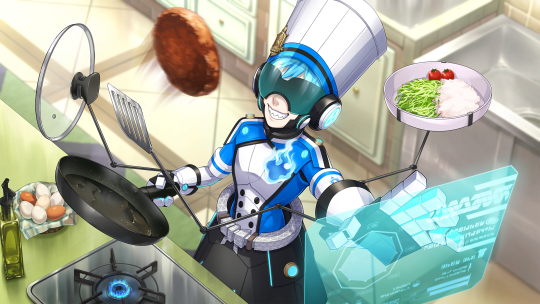
Requested by Anonymous.
#twisted wonderland#twst#ortho shroud#leona kingscholar#azul ashengrotto#twst ortho#twst azul#twst leona#twst translation#twst masterchef#mention: idia
129 notes
·
View notes
Text
F1 and Biometrics
Biometric gloves came into play in F1 in 2018 to give medical teams immediate access to important information regarding driver conditions after an incident. It allows for vitals to be measured before, at the time of an incident and after the crash until they are rescued and more advanced monitoring is able to be applied. It is also a big help if a driver is involved in a crash that means they are not accessible straight away or cannot be visualized for monitoring so this allows teams to get immediate access to this information.
According to the FIA website, this was a difficulty by medical teams when Carlos Sainz crashed in the 2015 Russian GP where he hit the barrier head-on at 153km/h (roughly 95mph). The first row of the barrier was resting on top of him, so medical teams had to wait for this to be removed before they had access to him. Thankfully he wasn’t hurt during this crash, but medical teams didn’t know this initially as this technology wasn’t available and being used.
The sensors were basically made custom to F1 drivers. Regular sensors had not been fire tested and were not comfortable enough for the drivers to wear for long races. They use Bluetooth technology and can send data within a 500m and are powered by a small battery that drivers charge before races.
Drivers gloves have a 3mm sensor that is stitched into the palm of the fabric and monitors their vital signs during races. They measure pulse oximetry which measures the amount of oxygen being carried in the blood as well as drivers pulse rates. Obviously if a driver has an injury that is affecting their breathing, this will show in the saturations that would decline rapidly. Having this technology allows physiological readings and biometrics to be continuously monitored throughout the race from start to finish. Data from the sensor transmits to an iPhone app and gives medical crews remote and advance information on the driver’s condition. The small biometric readers are flexible and fire resistant up to 1,800 degrees Celsius (3,272 degrees Fahrenheit) for 22 seconds.


In the future there are even plans to implement sensors for respiratory rate and temperature to further monitor drivers which will not only enhance safety features but allow teams and drivers to monitor performance better.
OMP, an equipment supplier, has been developing wearable biometric monitoring systems since the introduction of the biometric sensors in 2019. An undershirt equipped with sensors and a measurement unit would transmit and record biometric data allowing for real-time monitoring of health through ECG and thoracic expansion. This would allow monitoring of drivers heart rhythms and breathing rate which would not only benefit medical teams in the case of an incident but also help identify stress, fatigue and any alteration in conditions. This would be useful considering the amount of stress drivers have been put through in the past in hot countries for example Saudi Arabia GP 2023 when many drivers retired, had to be taken to medical, threw up in their helmets or passed out after the race.


TV crews can also display biometric data during broadcasts to show the physical condition of a driver as they battle on track. However, there have been questions about the ethics and use of biometrics and why can’t we as an audience see drivers heart rates etc on screen if this data is being constantly collected. The FIA has strict guidelines about the use of raw biometric data. Section 2.4 of the FIA Guidelines for the Collection and Usage of Biometric Data in Motorsport, states that the use of biometric data can be used for more than just medical and performance monitoring and can be used for entertainment and marketing purposes but only if it is changed from raw data into a variable to protect the private health information of the driver. The FIA won’t allow the use of biometric data to be publicly available in the original form/ measurement unless the driver provides informed consent.
Essentially, driver onboard vitals are likely not to be available live due to strict laws on data protection and sharing health related information about drivers as it is protected health information. In the case of an accident or emergency, data is not allowed to be used even if the information is changed to protect the driver unless it is for medical and rescue use and post-accident information.
Sources: (x) (x) (x) (x) (x)
This also led me down a rabbit hole and found another study (it was anonymous but if you’re a sleuth you can probably take a guess at what F1 driver it was) where they monitored his heart rate during qualifying to see what his average was throughout the race to test the cardiovascular strain F1 drivers are put under!
50 notes
·
View notes
Text
The US Coast Guard’s Titan submersible hearing kicked off with a startling revelation.
“I told him I’m not getting in it,” former OceanGate engineering director Tony Nissen said to a panel of Coast Guard investigators, referring to a 2018 conversation in which CEO Stockton Rush allegedly asked Nissen to act as a pilot in an upcoming expedition to the Titanic.
“It’s the operations crew, I don’t trust them,” Nissen told the investigators. “I didn’t trust Stockton either. You can take a look at where we started when I was hired. Nothing I got was the truth.”
Nissen’s testimony, which focused on the design, building, and testing of OceanGate’s first carbon fiber submersible, was a dramatic start to nearly two weeks of public testimony in the US Coast Guard Marine Board of Investigation’s hearings into the fatal June 2023 implosion of the Titan. Its five occupants, including Rush, all likely died instantly.
Before Nissen took the stand, the Coast Guard presented a detailed timeline of OceanGate as a company, the development of the Titan submersible, and its trips to the wreck of the Titanic, resting nearly 3,800 meters down in the north Atlantic. These slides revealed new information, including over 100 instances of equipment failures and incidents on the Titan’s trips in 2021 and 2022. An animated timeline of the final few hours of the Titan also included the final text messages sent by people on the sub. One sent at about 2,400 meters depth read “all good here.” The last message, sent as the sub slowed its descent at nearly 3,400 meters, read “dropped two wts.”
The Coast Guard also confirmed reports that the experimental carbon fiber sub had been stored in an outdoor parking lot in temperatures as low as 1.4 degrees Fahrenheit (–17 Celsius) in the run-up to last year’s Titanic missions. Some engineers worried that water freezing in or near the carbon fiber could expand and cause defects in the material.
Nissen said that almost from when he joined OceanGate in 2016, Rush kept changing the company’s direction. A move to certify the vessel with an independent third party fell by the wayside, as did plans to test more scale models of the Titan’s carbon fiber hull when one failed early under pressure. Rush then downgraded titanium components to save money and time. “It was death by a thousand cuts,” Nissen recalls.
He faced tough questioning about OceanGate’s choice of carbon fiber for a hull and its reliance on a newly developed acoustic monitoring system to provide an early warning of failure. One investigator raised WIRED’s reporting that an outside expert Nissen hired to assess the acoustic system later had misgivings about Rush’s understanding of its limitations.
“Given the time and constraints we had,” Nissen said, “we did all the testing and brought in every expert we could find. We built it like an aircraft.”
Nissen walked the Coast Guard board through deep-water testing in the Bahamas in 2018, during which he says the sub was struck by lightning. Measurements on the Titan’s hull later showed that it was flexing beyond its calculated safety factor. When a pilot subsequently found a crack in the hull, Nissen said, he wouldn’t sign off on another dive. “I killed it,” he testified. “The hull is done.” Nissen was subsequently fired.
Nissen sought to draw a line in the sand between the vessel he worked on and the one that took the fateful voyage to the Titanic. The latter had a replacement hull and a redesigned acoustic monitoring system. “My design was collecting data such that we would prevent a catastrophic failure and ultimately the loss of human life,” he said. “We did that with serial 1. What they did in serial number 2, I don’t know. “
The next witness, Bonnie Carl, worked at OceanGate for less than a year between 2017 and 2018. Carl was hired as a director of human resources and finances and was also training to be a pilot for OceanGate’s submersibles. Carl said that one of the company’s board members, former Coast Guard rear admiral John Lockwood, was brought in for oversight and “to show that we’re talking to the Coast Guard.”
She also echoed Nissen’s testimony that Rush was in complete control of the company: “There might be discussion, but in the end … all decisions were made by Stockon,” she said.
The final witness of the day was an OceanGate contractor and veteran submersible operator, Tym Catterson. Catterson is one of only two witnesses the Coast Guard has called who was among the 42 people aboard the Polar Prince, OceanGate’s support ship, that June. He was operating the floating platform used to transport, launch, and recover the Titan submersible.
The preparations for the Titan’s dive that day went smoothly, said Catterson: “The sun came out, there were no red flags, and it was one of the first times we ever launched on schedule.”
He did have positive things to say about OceanGate’s safety culture, noting that Titan’s predive checklist was longer and more thorough than those used by other submersibles. But Catterson also admitted to contributing to an “uncomfortable” incident on a previous Titan dive, where an incorrectly closed valve caused the sub to tilt, tumbling its passengers together for an hour.
Catterson was able to give only a very spotty account of events following Titan’s loss of communication. He repeatedly referred the board to OceanGate’s operations director Scott Griffith as someone who could provide a more complete account of the dive. Griffiths is not on the Coast Guard’s list of witnesses, nor are any employees of OceanGate’s operations team.
Catterson was there for the recovery of some of the Titan’s wreckage, however. He testified that the inside edge of one titanium ring was sheared off all the way around. One former OceanGate engineer believes this supports the theory that the implosion was allegedly caused by damage to the carbon fiber there, perhaps from freezing water or lifting the sub without using the correct equipment, rather than a failure of the hull from pressure alone.
The hearing continues this week and next.
28 notes
·
View notes
Text

100 Years Ago They Disappeared on Everest. But Did They Make it to the Summit?
It’s one of climbing’s greatest mysteries: was Everest really conquered for the first time in 1953, or did two mountaineers make it to the summit in 1924, before dying in mysterious circumstances?
British climbers George Mallory and Andrew “Sandy” Irvine were last seen on June 8, 1924, 800 feet below the peak, before disappearing into clouds. They never reemerged.
When Mallory’s body was found in 1999, hopes were high that it might give a clue as to whether the pair reached the summit. But, tantalizingly, the camera he had been carrying – with which he would have documented the highest point they had reached – was not on the body. Irvine’s body has never been found.
But now, as the 100th anniversary of the mens’ disappearance approaches, one researcher believes that he has solved mountaineering’s greatest mystery.
By studying the expedition weather reports, author Graham Hoyland believes that he has worked out what happened to the pair – and whether they made it to the summit before they died.
Hoyland – a distant relative of another member of the expedition group, who has visited on Everest nine times searching for the remains – believes that the key to the mystery is air pressure.
His relative several times removed, Howard Somervell – another mountaineer, who had got within 1,000 feet of the summit on the same expedition before a lack of oxygen meant he had to retreat – was responsible for tracking the weather during the expedition.
The smoking gun?

The 1924 expedition, including Irvine and Mallory (top two left), aimed to be the first documented ascent of the mountain.
His records – which he submitted after the official report on the 1924 expedition was made, having returned to his job as a surgeon in India – show that the barometric pressure dropped between the morning of June 8 and June 9 at base camp, where Somervell was taking the readings.
Somervell recorded the pressure in inches of mercury, dropping from 16.25 to 15.98. Hoyland believes that these figures equate to a 10 millibar drop in pressure. Weather-related deaths on Everest are generally associated with a drop in barometric pressure at the summit.
A decrease of just 4 millibars can trigger hypoxia; a 6 millibar drop was enough to cause the incident in 1996 in which 20 people were trapped on the mountain, eight of whom died. That story is recounted in writer Jon Krakauer’s book “Into Thin Air.” The bad weather angle was also explored in a 2010 paper by experts from the University of Toronto, led by G.W. Kent Moore.
“They were climbing into an absolute s***storm – not only a blizzard but a sort of snow bomb,” Hoyland told CNN. Hoyland has experienced “snow bombs” himself on Everest. “It’s terrifying – the temperature drops hugely, you’re gasping for breath. There are winds of 100 knots. One guy I know was blown off the mountain, and ended up further up the mountain,” he said.
Effectively, the drop in air pressure meant that the mountain suddenly became higher – around 650 feet higher, to be precise. Hoyland calls it “an invisible death trap.”
The pair – who were ascending along the northwest ridge – were already climbing against the odds. Mallory wrote in a letter to his wife that he put his chances of making the summit at 50 to one. Hoyland thinks it was more like 20 to one. But, he thinks, they would have had no idea what was about to hit them.
“Mallory had seen Norton and Somervell get to to within 1000 feet of the top on 4 June using no oxygen equipment; it would have seemed reasonable to assume that it was possible to reach the summit with the apparatus,” he writes in a forthcoming book.
“What he didn’t know was that the rapidly falling air pressure was effectively making the mountain even higher.
What’s more, the storm and blizzard wouldn’t just have made a drop in air pressure. The pair were wearing layers of silk, cotton and wool. Hoyland – who had a similar made-to-measure outfit on an Everest trip – says that the clothes are exceptionally comfortable but wouldn’t have provided the warmth to survive a blizzard or an overnight.
Previously, it has been speculated that the pair had reached the summit before dying on the way down, something that Hoyland calls “wishful thinking.”
“I’d been trying to prove that Mallory had climbed Everest for years and years – I wanted to prove that I was the 16th Briton to climb it, not the 15th. But unfortunately when you read facts and they’re different, you have to change your mind. You can’t carry on being a wishful thinker,” he says.
Until Hoyland, nobody had closely studied at the weather reports, which were held at the Royal Geographical Society in London.
The summit was eventually reached by Edmund Hillary, a New Zealand mountaineer, in 1953 – the first documented ascent of the peak.
A century of speculation:


The mystery of Mallory and Irvine has intrigued adventurers for decades.
In 1933, another mountaineer, Percy Wyn-Harris found an ax near the summit. It was assumed to have belonged to Irvine.
In 1936, another mountaineer, Frank Smythe, believed he had seen two bodies in the distance. Using a telescope, he saw them at around 8,100 meters, or 26,575 feet.
And Chinese mountaineer Wang Hongbao believed he saw a body during his 1975 ascent.
Finally, an expedition in 1999, instigated by Hoyland, found Mallory’s body at 26,700 feet –2,335 below the summit.
Hoyland believes that the pair, tethered to each other, slipped while aborting the climb and returning to base camp. He thinks Mallory survived the initial fall, but took another, fatal plunge while staggering back to base camp. Irvine’s body has never been found.
Everest ‘Makes People Mad’:




While some of Mallory’s possessions were still to be found on his body, including a pair of goggles in his pocket – which suggests he was either in darkness or poor visibility – there was no sign of the photo of his wife which he had brought, planning to leave it on the summit.
For decades, researchers have posited that, in lieu of more precise evidence, the lack of photo suggests the pair might have reached the summit and fallen while returning.
However, having reviewed the new evidence, Hoyland believes this is not the case. Expedition reports noted a blizzard hitting the mountain at 2 p.m., he says – long before they could have reached the summit. The lack of photo, he thinks, means nothing. Mallory often forgot stuff, he notes.
In his last letter to his wife – digitized to mark the centenary of his ascent – on May 27, Mallory wrote of “looking out of a tent door onto a world of snow and vanishing hopes: and described it as “a bad time altogether.” Both he and Irvine were unwell, and he wrote that “I’m quite doubtful if I shall be fit enough.”
For Hoyland, who is taking part in an event at the Royal Geographical Society about the centenary, “Everest makes people mad.”
“Mallory became obsessed with the desire to conquer Everest – it would have made him somebody,” he said.
Mallory was a teacher, but moved on the fringes of the Bloomsbury set, a group of British intellectuals, artists and thinkers centered on London in the early 20th century.
“Everyone he knew was a famous novelist or a Nobel prizewinner, and he got captivated by it [the idea of Everest],” he said.
“There’s a dangerous thing called ‘summit fever’ – you see the summit, and you think, ‘Right, it’s death or glory.’ You don’t care if you die.
“I know that feeling. You get completely possessed by this mountain. Mallory was possessed by Everest and it killed him.”
Hoyland, who has since swapped mountaineering for extreme sailing, says that Everest has become “a non-mountaineer’s mountain.”
“There are rich men climbing it as a trophy. I wish it wasn’t the highest,” he said.
“Quite honestly I think the best thing to happen would be if the top 800 feet fell off.
By Julia Buckley.


#100 Years Ago They Disappeared on Everest#George Mallory#Andrew “Sandy” Irvine#Mount Everest#mountaineer#mountain climbing#1924 British Everest Expedition#history#history news#long post#long reads
53 notes
·
View notes
Text
The Definitive Manual for Mastering Perfectly Tender Rice with Your TOSHIBA Rice Cooker
When it comes to cooking rice, precision and consistency are key. The TOSHIBA Rice Cooker is designed to deliver perfectly tender rice every time, thanks to its advanced features and user-friendly design.

Why Choose the TOSHIBA Rice Cooker?
The TOSHIBA Rice Cooker is not just a rice cooker; it is a versatile kitchen appliance designed to meet a variety of cooking needs. With its Fuzzy Logic Technology, it adjusts cooking parameters to ensure perfect results every time.
Features of the TOSHIBA Rice Cooker
8 Cooking Functions: White Rice, Quick Cook, Brown Rice, Mixed Grain, Slow Cook, Porridge, Cake, and Egg.
LCD Display: Easy-to-read display for intuitive operation.
Fuzzy Logic Technology: Automatically adjusts cooking time and temperature.
24-Hour Delay Timer: Plan your meals in advance.
Auto Keep Warm: Keeps your rice warm until you are ready to serve.
Non-Stick Inner Pot: Easy to clean and maintain.
Getting Started with Your TOSHIBA Rice Cooker
Before you begin cooking, it is important to familiarize yourself with the different components of your TOSHIBA Rice Cooker. This includes the inner pot, the LCD display, and the various cooking functions available.
"The Toshiba Small Rice Cooker, with a capacity for 3 cups uncooked rice, is designed for convenience and versatility. It features an LCD display with 8 cooking functions, including options for white rice, brown rice, mixed grain, quick cook, slow cook, porridge, cake, and egg. Utilizing Fuzzy Logic Technology, it adjusts cooking time and temperature for perfect results. The 24-hour delay timer and auto keep warm function ensure your rice is ready when you are. Its non-stick inner pot makes cleaning easy, and the cooker comes with a rice ladle, spoon, and measuring cup. Ideal for small families or individuals, it offers a compact and efficient solution for a variety of cooking needs." - Product Introduction
Step-by-Step Guide to Cooking Perfect Rice
Measure the Rice: Use the measuring cup provided to measure the desired amount of rice.
Rinse the Rice: Rinse the rice under cold water until the water runs clear.
Add Water: Add the appropriate amount of water to the inner pot. The TOSHIBA Rice Cooker typically has water level markings inside the pot to guide you.
Select the Cooking Function: Choose the appropriate cooking function on the LCD display. For example, select "White Rice" for regular white rice.
Start Cooking: Press the start button to begin cooking. The TOSHIBA Rice Cooker will automatically adjust the cooking time and temperature.
Let it Rest: Once the cooking cycle is complete, let the rice rest for a few minutes before opening the lid.
Fluff and Serve: Use the rice ladle to fluff the rice before serving.
Additional Cooking Functions
The TOSHIBA Rice Cooker is equipped with multiple cooking functions that allow you to prepare a variety of dishes. Here are some of the additional functions you can explore:
Quick Cook: Ideal for when you are in a hurry and need to cook rice quickly.
Brown Rice: Perfect for cooking brown rice, which requires a longer cooking time.
Mixed Grain: Great for cooking mixed grains such as quinoa and barley.
Slow Cook: Use this function to slow cook stews and soups.
Porridge: Make delicious porridge for breakfast.
Cake: Yes, you can even bake cakes in your TOSHIBA Rice Cooker!
Egg: Cook perfect eggs every time.
Maintenance and Cleaning
Proper maintenance and cleaning of your TOSHIBA Rice Cooker will ensure its longevity and optimal performance. Here are some tips:
Unplug the Cooker: Always unplug the rice cooker before cleaning.
Remove the Inner Pot: Take out the non-stick inner pot and wash it with warm soapy water. Avoid using abrasive cleaners.
Wipe the Exterior: Use a damp cloth to wipe the exterior of the rice cooker.
Clean the Lid: Remove and clean the lid if it is detachable. Otherwise, wipe it with a damp cloth.
Dry Thoroughly: Ensure all parts are completely dry before reassembling the rice cooker.
Customer Reviews
The TOSHIBA Rice Cooker has received numerous positive reviews from customers who appreciate its versatility and ease of use. Here are some highlights:
"I love my Toshiba Rice Cooker! It makes perfect rice every time, and the additional cooking functions are a great bonus." - Customer Review
"The Fuzzy Logic Technology really makes a difference. My rice comes out perfectly cooked, and I love the convenience of the 24-hour delay timer." - Customer Review
Where to Buy
You can purchase the TOSHIBA Rice Cooker from various online retailers. For more information and to buy, visit the product page on Amazon.
Conclusion
The TOSHIBA Rice Cooker is a versatile and reliable kitchen appliance that makes cooking rice and other dishes a breeze. With its advanced features and user-friendly design, it is an excellent addition to any kitchen.
20 notes
·
View notes